
|
 |
 |
 |
 |
 |
EGG‑NEWS.com
Egg Industry News, Comments & More by
Simon M.Shane
|
 |
 |
 |
 |
 |
 |
Egg Industry News
USDA-WASDE REPORT #666. December 9th 2025
|
12/09/2025 |
|
OVERVIEW
 Understandably the December 9th edition of the World Agriculture Supply and Demand Estimates (WASDE) #666 was little changed with respect to corn and soybeans from the post-shutdown November 18th edition reflecting the 2025 crop. Crop size and ending stocks were derived from actual harvest data, projections for domestic use and the effect of tariff policy and competition that influence export volumes Understandably the December 9th edition of the World Agriculture Supply and Demand Estimates (WASDE) #666 was little changed with respect to corn and soybeans from the post-shutdown November 18th edition reflecting the 2025 crop. Crop size and ending stocks were derived from actual harvest data, projections for domestic use and the effect of tariff policy and competition that influence export volumes
The December WASDE report reconfirmed that the 2025 corn crop was harvested from an expanded 90.0 million acres, (82.7 million acres in 2024). The soybean crop was harvested from a reduced 80.3 million acres, (86.3 million acres in 2024).
The December WASDE yield value for the 2025 corn crop was retained at 186.0 bushels per acre, unchanged from November. By comparison corn yield was 183.1 bushels per acre in 2024. Soybean yield was held at 53.0 bushels per acre, unchanged from November reflecting harvest data. By comparison soybean yield was 51.7 bushels per acre for the previous 2024 crop.
 The December WASDE projection for the ending stock of corn was lowered by 5.8 percent from November to 2,029 million bushels. The December USDA projection for the ending stock of soybeans was unchanged from November at 290 million bushels consistent with domestic use and export projections. The December WASDE projection for the ending stock of corn was lowered by 5.8 percent from November to 2,029 million bushels. The December USDA projection for the ending stock of soybeans was unchanged from November at 290 million bushels consistent with domestic use and export projections.
The December WASDE retained the projected corn price for the 2025-2026 market year at an average of 400 cents per bushel. The projected average season price for soybeans was held at 1,050 cents per bushel. The price of soybean meal was unchanged from November at $300 per ton.
USDA commodity prices suggest higher feed costs for livestock and poultry producers especially if promised exports materialize. Farmers including corn growers will then benefit from increased prices. In some areas return from corn will be below break-even given relative yields, production costs and depressed per bushel prices. The USDA has announced an allocation of $12 billion to row-crop farmers to compensate for prolonged low commodity prices resulting from reduced exports occasioned by tariffs imposed by the U.S.
Projections for world output included in the December 2025 WASDE report, reflect the most recent estimates for the production and export of commodities especially in the Southern Hemisphere with an emphasis on volumes and prices offered by Argentine and Brazil. Economists also considered the impact of weather patterns arising from the La Nina event especially on South America.
It is accepted that USDA projections for exports will be influenced by the fluid situation relating to tariffs. Estimates of exports are also based on the perceived intentions and needs of China. This Nation sharply curtailed purchases of commodities and especially U.S. soybeans during the 2024-2025 market year and the current year to date.
CORN
Production parameters for corn were unchanged from the November WASDE, reflecting actual harvest data and updated projections for domestic use and trade. The December WASDE Report projected a 2025 crop of 16,752 million bushels, compared to 15,413 million bushels for the previous 2024 record harvest. The “Feed and Residual” category was unchanged from September at 6,100 million bushels. The Food and Seed category was projected at 1,380 million bushels. The Ethanol and Byproducts Category was retained at 5,600 million bushels consistent with estimated demand for E-10 and higher blends for driving needs in late fall and winter months. Projected corn exports were raised 4.1 percent to 3,300 million bushels, based on recent orders and shipments. The anticipated ending stock of corn will be 2,029 million bushels or 11.1 percent of projected availability.

The forecast USDA average season farm price for corn in the December WASDE report was 400 cents per bushel. At close of trading after the noon November 14th release of the WASDE, the CME spot price for corn was 448 cents per bushel, 12.0 percent above the USDA projection but unchanged from the November 18th CME price.
DECEMBER 2025 WASDE #666 Summary for the 2025 Corn Harvest:
|
Harvest Area
|
90.0 million acres
|
(98.7 m. acres planted, with harvest corresponding to 91.2% of acres planted)
|
|
Yield
|
186.0 bushels per acre
|
(Updated from 186.7 bushels per acre in the Sept. WASDE)
|
|
Beginning Stocks
|
1,532 m. bushels
|
|
|
Production
|
16,752 m. bushels
|
|
|
Imports
|
25 m. bushels
|
|
|
Total Supply
|
18,309 m. bushels
|
Proportion of Supply
|
|
Feed & Residual
|
6,100 m. bushels
|
33.3%
|
|
Food & Seed
|
1,380 m bushels
|
7.5%
|
|
Ethanol & Byproducts
|
5,600 m. bushels
|
30.6%
|
|
Domestic Use
|
13,080 m. bushels
|
71.4%
|
|
Exports
|
3,200 m. bushels
|
17.5%
|
|
Ending Stocks
|
2,029 m. bushels
|
11.1%
|
Average Farm Price: 400 cents per bushel. (Unchanged from the December WASDE)
SOYBEANS
Projections for soybeans were retained from the November WASDE, with a 2025 yield of 53.0 bushels per acre but with a reduced area of 81.1 million acres planted compared to 2024. The December WASDE retained the soybean crop at 4,254 million bushels. Crush volume was held from November at 2,555 million bushels despite recently increased industry capacity. Projected exports were held at 1,635 million bushels despite the prospect of increased imports by China following uncertainty over tariffs and diplomatic conflict. Ending stocks were anticipated to be 290 million bushels, unchanged from the November WASDE. Prior to 2018, China, the largest trading partner for U.S. agricultural commodities, imported the equivalent of 25 percent of U.S. soybeans harvested.
 The December USDA WASDE projection for the ex-farm price for soybeans was unchanged from November at 1,050 cents per bushel. At close of trading on December 9th following the noon release of the WASDE, the CME spot price was 1,088 cents per bushel, 3.6 percent above the December USDA projection and 3.5 percent below the November 18th CME price. The December USDA WASDE projection for the ex-farm price for soybeans was unchanged from November at 1,050 cents per bushel. At close of trading on December 9th following the noon release of the WASDE, the CME spot price was 1,088 cents per bushel, 3.6 percent above the December USDA projection and 3.5 percent below the November 18th CME price.
DECEMBER 2025 WASDE #666 Summary for the 2025 Soybean Harvest:-
|
Harvest Area
|
80.3 million acres
|
81.1 m. acres planted. Harvest corresponding to 99.0% of planted acreage)
|
|
Yield
|
53.0 bushels per acre
|
(Updated from 53.5 bushels/acre in the September WASDE)
|
|
Beginning Stocks
|
316 m. bushels
|
|
|
Production
|
4,254 m. bushels
|
|
|
Imports
|
20 m. bushels
|
|
|
Total Supply
|
4,590 m. bushels
|
Proportion of Supply
|
|
Crush Volume
|
2,555 m. bushels
|
55.7%
|
|
Exports
|
1,635 m. bushels
|
35.6%
|
|
Seed
|
73 m. bushels
|
1.6%
|
|
Residual
|
37 m. bushels
|
0.8%
|
|
Total Use
|
4,300 m. bushels
|
93.7%
|
|
Ending Stocks
|
290 m. bushels
|
6.3%
|
Average Farm Price: 1,050 cents per bushel (Unchanged from November)
SOYBEAN MEAL
The projected parameters for soybean meal were retained from the November WASDE. Production will attain 60.2 million tons, consistent with the unchsnged soybean crush volume of 2,555 million bushels. Projected production reflects the stagnant demand for biodiesel despite expanded U.S. crushing capacity. Crush volume is driven both by exports and domestic consumption for livestock feed and for soy oil supplying the food and biodiesel segments. The projection of domestic use was 41.7 million tons. Exports were estimated at 19.2 million tons.
The USDA projected the ex-plant price of soybean meal at $300 unchanged from the November WASDE as an average for the season based on supply and demand considerations. USDA predicted an ending stock of 475,000 tons representing 0.8 percent of supply.
At close of trading on December 9th the CME spot price for soybean meal was $301 per ton, up $1 per ton (0.3 percent) compared to the December WASDE projection of $300 per ton and down 8.2 percent from the November 18th CME price.
DECEMBER 2025 WASDE #666 Projection of Soybean Meal Production and Use
|
Beginning Stocks
|
450
|
|
Production
|
60,225
|
|
Imports
|
675
|
|
Total Supply
|
61,350
|
|
Domestic Use
|
41,675
|
|
Exports
|
19,200
|
|
Total Use
|
60,875
|
|
Ending Stocks
|
475
|
(Quantities in thousand short tons)
Average Price ex plant:$300 per ton (Unchanged from the November WASDE)
IMPLICATIONS FOR PRODUCTION COST
The price projections based on CME quotations for corn and soybeans suggest higher feed production costs for broilers and eggs. Going forward, prices of commodities will be determined by World supply and demand and U.S. domestic use and exports.
For each 10 cents per bushel change in corn:-
- The cost of egg production would change by 0.45 cent per dozen
- The cost of broiler production would change by 0.25 cent per live pound
For each $10 per ton change in the cost of soybean meal:-
- The cost of egg production would change by 0.35 cent per doze
- The cost of broiler production would change by 0.30 cent per live pound.
WORLD SITUATION
With respect to world coarse grains and oilseeds the December 2025 WASDE Report included the following appraisals by USDA:-
COARSE GRAINS:
“Global coarse grain production for 2025/26 is forecast down slightly to 1.576 billion tons. The
2025/26 foreign coarse grain outlook is for lower production, trade, and higher ending stocks
relative to last month. Foreign corn production is cut with declines for Ukraine, Canada,
Nigeria, Indonesia, and Senegal partially offset by increases for the EU, Russia, and
Zimbabwe. Ukraine corn production is sharply lower with reductions to both area and yield
based on reported government data to date, where harvest has been slow as a result of wet
conditions in key growing areas. Canada corn is reduced based on the latest information
from Statistics Canada. The EU is raised reflecting increases for Spain, Hungary, Romania,
and Poland. Foreign barley production is higher with increases for Canada, the EU, and
Australia”.
“Corn exports for 2025/26 are raised for the United States but lowered for Ukraine. Corn
imports are higher for Colombia with cuts for the EU and Zimbabwe. Barley exports are
raised for Australia, Canada, and the EU while Ukraine is reduced. Foreign corn ending
stocks are higher based on an increase for Argentina partly offset by declines for Ukraine
and Canada. Global corn stocks, at 279.2 million tons, are down 2.2 million”.
OILSEEDS:
 “Global oilseed production for 2025/26 is raised this month, driven mainly by higher rapeseed, peanut, and soybean production, partially offset by lower sunflowerseed output. Global rapeseed production is raised 3.0 million tons, with increases for Canada, Australia, and Russia. Canada has the largest increase, up 2.0 million tons to a record 22.0 million, based on the latest Statistics Canada report. Higher rapeseed production is mostly offset by lower global sunflowerseed production, down 2.5 million tons on harvest results for Ukraine and Russia. Current and historical peanut production is raised for Nigeria on official area data. “Global oilseed production for 2025/26 is raised this month, driven mainly by higher rapeseed, peanut, and soybean production, partially offset by lower sunflowerseed output. Global rapeseed production is raised 3.0 million tons, with increases for Canada, Australia, and Russia. Canada has the largest increase, up 2.0 million tons to a record 22.0 million, based on the latest Statistics Canada report. Higher rapeseed production is mostly offset by lower global sunflowerseed production, down 2.5 million tons on harvest results for Ukraine and Russia. Current and historical peanut production is raised for Nigeria on official area data.
The 2025/26 global soybean outlook includes higher production, increased crush, lower exports, and raised ending stocks.”
“Global soybean production is increased 0.8 million tons to 422.5 million, reflecting higher crops for Russia and India but lower output for Canada and Ukraine. Global soybean crush for 2025/26 is increased 0.3 million tons to 365.2 million, mainly on higher supplies in Russia and India. Global soybean exports are lowered 0.3 million tons on lower shipments for Ukraine and Benin. Imports are reduced for Japan, Russia, and Saudi Arabia but raised for Brazil. Global soybean ending stocks are increased 0.4 million tons to 122.4 million, mainly on higher stocks for Brazil and Russia”.
World and U.S. Data Combined for Coarse Grains and Oilseeds:-
|
Factor: Million m. tons
|
Coarse Grains
|
Oilseeds
|
|
Output
|
1,576*
|
690
|
|
Supply
|
1,898
|
832
|
|
World Trade
|
249
|
215
|
|
Use
|
1,588
|
578
|
|
Ending Stocks
|
310
|
144
|
*Values rounded to one million metric ton
(1 metric ton corn= 39.37 bushels. 1 metric ton of soybeans = 36.74 bushels)
(“ton” represents 2,000 pounds)

|
Brought to you by Big Dutchman
|
12/07/2025 |
|
This December pre-IPPE edition of EGG-NEWS is sponsored by Big Dutchman USA. In addition to industry news and available statistics new products to be released at the IPPE are detailed. The commitment of the Company to innovation in design and construction of equipment will benefit the poultry industry through enhancing efficiency. Subscribers can access www.bigdutchman.com for additional information and specifications for the range of new products as featured.

|
Cal-Maine Foods Commits Capital to Further Processed Egg Products
|
12/07/2025 |
|
 In a December 3rd announcement, Cal-Maine Foods Inc. (CALM) announced investment of $15 million in Echo Lake Foods. Capital assigned will allow installation of equipment for scrambled egg production, consolidating this process in an efficient plant with an output of 17 million pounds annually. Previously Cal-Maine Foods committed $15 million to a high-speed pancake line with an ultimate capacity of 12 million pounds. Joint venture Crepini Foods will receive $7 million through fiscal 2028 to add 18 million pounds to annual production over a two-year period. In a December 3rd announcement, Cal-Maine Foods Inc. (CALM) announced investment of $15 million in Echo Lake Foods. Capital assigned will allow installation of equipment for scrambled egg production, consolidating this process in an efficient plant with an output of 17 million pounds annually. Previously Cal-Maine Foods committed $15 million to a high-speed pancake line with an ultimate capacity of 12 million pounds. Joint venture Crepini Foods will receive $7 million through fiscal 2028 to add 18 million pounds to annual production over a two-year period.
The combined investment will increase production capacity of further-processed high-value egg products by 30 percent over the proximal two years. This is consistent with the dominant position of Cal-Maine Foods as the U.S. and the world’s largest producer of shell eggs.
In announcing the expansion and the appointment of Jonathan Zoeller as CFO of Prepared Foods and the promotion of Dave Jordan to president of Echo Lake Foods, CEO Sherman Miller noted, “These prepared foods investments are a critical component of our multi-year plan to strengthen mid-cycle earnings, enhance portfolio resilience and capture accelerated demand for high-protein, ready-to-eat convenience formats.” Miller added, “By investing in our facilities and building an exceptional leadership team we believe we can create a bigger, stronger, more capable prepared foods platform for the years ahead.”

|
Florida to Investigate Campbell Allegation
|
12/03/2025 |
|
In an exercise in judicial theater, James Uthmeier, Attorney General of the State of Florida announced an investigation into the source of chicken in Campbell’s Company products. The Consumer Protection Division of the Florida agency will spearhead the unnecessary effort.
 The Florida action arises from revelations in a lawsuit initiated by Plaintiff. Robert Garza, who is suing Campbell for employment discrimination. In a clandestine recording entered into evidence, the discredited and since terminated Vice President Martin Bally the former Chief Information Security Officer, deprecated both Campbell’s products and consumers and claimed that the company was incorporating “bio-engineered meat” in soups. The Florida action arises from revelations in a lawsuit initiated by Plaintiff. Robert Garza, who is suing Campbell for employment discrimination. In a clandestine recording entered into evidence, the discredited and since terminated Vice President Martin Bally the former Chief Information Security Officer, deprecated both Campbell’s products and consumers and claimed that the company was incorporating “bio-engineered meat” in soups.
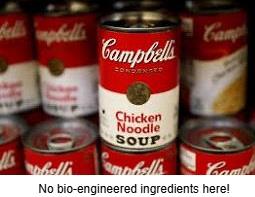 This statement should have been dismissed as simple puffery and uninformed hyperbole. In the first instance, bio-engineered chicken is not available in commercial quantities. The second indication of improbability, is that the cost of any bio-engineered meat would far exceed the natural product, obviously disfavoring use. This statement should have been dismissed as simple puffery and uninformed hyperbole. In the first instance, bio-engineered chicken is not available in commercial quantities. The second indication of improbability, is that the cost of any bio-engineered meat would far exceed the natural product, obviously disfavoring use.
It would appear that the Office of the Attorney General is pursuing an obvious slander to generate partisan publicity and to create the illusion of enforcing state legislation banning production and sale of non-available laboratory-produced meat. Surely there are more substantive issues to consider in the State. In a legal environment dominated by ideology, logic is the evident loser.

|
Vampire Bats Yield H5N1 Avian Influenza Virus in Peru
|
12/02/2025 |
|
A recent epidemiologic study demonstrated that vampire bats (Desmodus rotundus) can be infected with H5N1 avian influenza virus. The study conducted in Peru differentiated between two locations of bats reflecting coastal and inland communities. Bats preying on marine mammals and birds demonstrated antibodies to the virus only after the epidemic among marine mammals. There was little evidence of sustained transmission among bats in the implicated colony with only eight percent showing seroconversion. Inland bats that prey on livestock did not show antibodies to H5N1.

Bat species including flying foxes (Pteropus giganteus) acquired H5N1 in Bangladesh during 2023. In this report the frugivorous bats were in all probability infected by cohabitation with affected crows.

In laboratory investigations complementary to the field studies in Peru the research team at The University of Glasgow demonstrated that H5 antigen binds to respiratory tissue of vampire bats Bat-derived lung, liver and kidney cell preparations supported growth of avian and mammalian H5 clade 2.3.4.4b virus.
In commenting on the significance of the study on vampire bats Dr. Richard Webby, a prominent virologist affiliated to St. Jude Childrens’ Research hospital noted that the findings “were not something we should get too worried about”. He added “Anytime we find H5N1 in a different species or a different route of infection, that increases the pandemic risk”.
Tu, I-Ting. Spillover of H5 influenza virus to vampire bats at the marine-terrestrial interface. bioRXiv doi.org/10.1101/2025.11.09.686930

|
Publicly Funded Supermarket Operating in Atlanta
|
12/02/2025 |
|
 Following the reluctance of supermarket operators to establish stores in urban areas of Atlanta, Mayor Andre Dickens established a program to locate the Azalea Fresh Market in an available 20,000-square-foot location. The endeavor required investment of public funds totaling $8 million in cash, grants and loans. The enterprise is projected to become profitable within three years. Based on the initial success of the store a second location will be developed for the convenience of residents in ‘supermarket deserts’. Azalea Fresh Market offers fruit, vegetables and dairy products in addition to essentials but lacks the frills of a modern suburban supermarket. Following the reluctance of supermarket operators to establish stores in urban areas of Atlanta, Mayor Andre Dickens established a program to locate the Azalea Fresh Market in an available 20,000-square-foot location. The endeavor required investment of public funds totaling $8 million in cash, grants and loans. The enterprise is projected to become profitable within three years. Based on the initial success of the store a second location will be developed for the convenience of residents in ‘supermarket deserts’. Azalea Fresh Market offers fruit, vegetables and dairy products in addition to essentials but lacks the frills of a modern suburban supermarket.
 NY Mayor-elect Zohran Mandani proposed establishing city-supported grocery stores as part of his successful campaign although the concept was not expanded to a specific program or plan of action. NY Mayor-elect Zohran Mandani proposed establishing city-supported grocery stores as part of his successful campaign although the concept was not expanded to a specific program or plan of action.
Although many cities have proposed and implemented subsidized markets under civic ownership, theft and other crimes have impacted community support and few have attained profitability or even survived. Various models have been attempted including support by cities in the form of loans and operation free of rent and taxes. Established supermarket chains have developed stores in underserved inter-city areas of metropolitan areas including Chicago without success leading to closure.
To be viable, public-supported grocery stores and supermarkets require professional management but above all community support to establish a crime-free environment.

|
Beyond Meat Loses Trademark Infringement Case
|
12/02/2025 |
|
 In 2022 Sonate Corp. dba Vegadelphia Foods filed a trademark infringement lawsuit against Beyond Meat Inc. and the parent company of Dunkin’ Donuts. The plaintiffs complained that the Beyond Meat slogan, Great taste, Plant-based was too similar to the registered trademark of Sonate, Where great taste is Plant-based. Sonate claimed that the infringement interfered with potential joint ventures and impacted company growth. In 2022 Sonate Corp. dba Vegadelphia Foods filed a trademark infringement lawsuit against Beyond Meat Inc. and the parent company of Dunkin’ Donuts. The plaintiffs complained that the Beyond Meat slogan, Great taste, Plant-based was too similar to the registered trademark of Sonate, Where great taste is Plant-based. Sonate claimed that the infringement interfered with potential joint ventures and impacted company growth.
The lawsuit was transferred to the jurisdiction of Massachusetts in 2023 with the most recent trial favoring the plaintiff. The judgement included $24 million in actual damages plus $15 million in profits. Given the perilous financial state of Beyond Meat it is questioned whether Sonate will recover damages.
For Q3 2025 the Company announced a net loss of $110.7 million, (including a charge of $77.4 million) on revenue of $70.2 million. With a negative EPS of ($1.44). For the corresponding Q3 2024bthe Company lost $26.6 million on revenue of $81.0 million with an EPS of ($0.41). Sales declined 13.3 percent and gross margin fell from 17.6 to 13.3 percent in comparing Q3 for the consecutive years.

On a 12-month trailing basis Beyond Meat has attained a negative operating margin of 47 percent and a negative profit margin of 81 percent. Over 12 months BYND has ranged from $0.50 to $7.60 with a 50-day moving average of $1.68. Before the close on December 2nd BYND was down over 2 percent to $1.31. Marked volatility is attributed to a succession of ‘short squeezes’ with 20.7 percent of the float short in mid-November.

|
Initiation of HPAI Vaccination of Birds in Singapore Sanctuary
|
12/01/2025 |
|
 A Memorandum of Understanding has been entered into between Ceva Wildlife Research Fund, Ceva Animal Health and National Parks Board of Singapore and Mandai Wildlife Group. It is intended to vaccinate endangered species against highly pathogenic avian influenza (HPAI) given the worldwide prevalence of avian influenza and the vulnerability of the Mandai sanctuary. The pilot program will include immunization of the most vulnerable species including the white-backed vulture (Gyps africanus), the marbled teal (Marmaronetta angustirostris) and other raptors. The pilot project will provide details on the immunologic response of recipient birds and will also assist duration of immunity. A Memorandum of Understanding has been entered into between Ceva Wildlife Research Fund, Ceva Animal Health and National Parks Board of Singapore and Mandai Wildlife Group. It is intended to vaccinate endangered species against highly pathogenic avian influenza (HPAI) given the worldwide prevalence of avian influenza and the vulnerability of the Mandai sanctuary. The pilot program will include immunization of the most vulnerable species including the white-backed vulture (Gyps africanus), the marbled teal (Marmaronetta angustirostris) and other raptors. The pilot project will provide details on the immunologic response of recipient birds and will also assist duration of immunity.
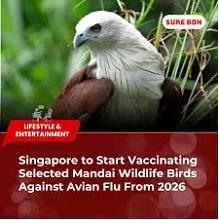 The program essentially follows the emergency vaccination of the highly endangered California condor (Gymnogyps californianus) in 2023 preserving this species highly susceptible to avian influenza as a result of consuming carcasses of dead birds. The program essentially follows the emergency vaccination of the highly endangered California condor (Gymnogyps californianus) in 2023 preserving this species highly susceptible to avian influenza as a result of consuming carcasses of dead birds.
The Ceva Wildlife Research Fund will spearhead the practical aspects of the program using CEVA vaccines with the Mandai wildlife Group monitoring the health of birds.
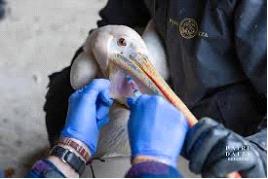 Marc Prikazsky chairman and CEO of CEVA Animal Health and also president of CEVA Wildlife Research Fund stated, “This collaboration truly reflects the essence of the One Health approach – bringing together scientific innovation, veterinary knowledge and a commitment to wildlife conservation. Marc Prikazsky chairman and CEO of CEVA Animal Health and also president of CEVA Wildlife Research Fund stated, “This collaboration truly reflects the essence of the One Health approach – bringing together scientific innovation, veterinary knowledge and a commitment to wildlife conservation.
The joint scientific and monitoring committee with representatives of the participants will ensure release of information and publication of data that will benefit poultry health professionals.

|
Contamination of Infant Formula Revisited
|
12/01/2025 |
|
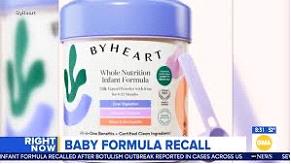
yHeart a small-scale manufacturer of infant formula, in a market dominated by a few majors, has recalled all products as a result of contamination with spores of Clostridium botulinum. Since August, 31st 35 cases have been confirmed in infants with at least 70 under investigation. Fortunately, no fatalities have been reported. The diagnosis is based on clinical observations and is followed by effective available treatment.
 Similarities with this case and the major 2022 recall from the Abbott, Sturgis, MI. facility are striking. At issue is the failure of the Food and Drug Administration (FDA) to effectively monitor production plants and to enforce either corrective action or closure. The most recent investigation disclosed three isolations of Clostridium spores from 36 unopened containers suggesting a high level of contamination in the Allerton, IA. facility. Disclosures obtained under the Freedom of Information Act confirmed an unsatisfactory situation with regard to the plant dating back to 2022. Deficiencies documented in official warning letters included the presence of pests, defective structures including ceilings and floors, failure to maintain an appropriate pathogen surveillance program, incorporation of untested ingredients, previous isolations of Cronobacter and an observation that “the Byheart plant was not designed to facilitate maintenance and sanitary operations”. It is significant that the company received approximately 2,000 complaints relating mainly to organoleptic quality but also some health-related complaints including nine characterized by the FDA as “sensitive/serious”. Similarities with this case and the major 2022 recall from the Abbott, Sturgis, MI. facility are striking. At issue is the failure of the Food and Drug Administration (FDA) to effectively monitor production plants and to enforce either corrective action or closure. The most recent investigation disclosed three isolations of Clostridium spores from 36 unopened containers suggesting a high level of contamination in the Allerton, IA. facility. Disclosures obtained under the Freedom of Information Act confirmed an unsatisfactory situation with regard to the plant dating back to 2022. Deficiencies documented in official warning letters included the presence of pests, defective structures including ceilings and floors, failure to maintain an appropriate pathogen surveillance program, incorporation of untested ingredients, previous isolations of Cronobacter and an observation that “the Byheart plant was not designed to facilitate maintenance and sanitary operations”. It is significant that the company received approximately 2,000 complaints relating mainly to organoleptic quality but also some health-related complaints including nine characterized by the FDA as “sensitive/serious”.
 It appears that FDA has not learned anything from the Abbott episode and that the Agency has obvious deficiencies in their oversight of plants manufacturing food products and pharmaceuticals. Regrettably the Agency has been politicized and there is little hope for practical improvement given the exodus of experienced managers, a deliberate reduction in staff, resignations and retirements all prompted by current policies of the Department of Health and Human Services. The appointment of incompetent or unqualified management based on ideology and conformity with non-scientific principles as expressed by Robert F. Kennedy Jr, Secretary of the Department suggest future health problems related to failure of the FDA to fulfil the missions detailed and funded by Congress. It appears that FDA has not learned anything from the Abbott episode and that the Agency has obvious deficiencies in their oversight of plants manufacturing food products and pharmaceuticals. Regrettably the Agency has been politicized and there is little hope for practical improvement given the exodus of experienced managers, a deliberate reduction in staff, resignations and retirements all prompted by current policies of the Department of Health and Human Services. The appointment of incompetent or unqualified management based on ideology and conformity with non-scientific principles as expressed by Robert F. Kennedy Jr, Secretary of the Department suggest future health problems related to failure of the FDA to fulfil the missions detailed and funded by Congress.

|
Dr. Seth Meyer Departs USDA
|
12/01/2025 |
|

The U.S. Department of Agriculture has announced that Dr. Seth Meyer, Chief Economist, since 2021 will leave the Agency. He will assume the position of Director of the Food and Agriculture Policy Research Institute at the University of Missouri, effective January 1, 2026.
His departure will be a loss to the USDA, adding to the loss of research staff and experienced personnel who left the agency after the ill-advised transfer of the Economic Research Service from Washington to Kansas City during the first administration of President Trump. This was followed by the unprecedented layoff of government personnel during the first few months of 2025.
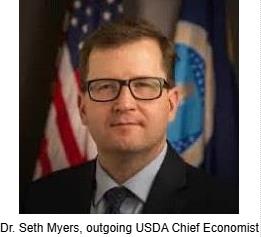
Dr. Meyer was in large measure responsible for compilation and distribution of the monthly World Agriculture Support and Demand Estimates Report a respected and widely used periodical.

It is considered significant that contrary to silence on the recent departures of senior administrators, Brooke Rollins, Secretary of the USDA expressed gratitude for the contributions made by Dr. Meyer and his lasting impact on the Department and U.S. agriculture.
EGG-NEWS along with the poultry industry acknowledges his achievements over an extensive career and anticipates further advances in research, service and teaching in his new position at the University of Missouri.

|
H5 Pandemic Warning from Pasteur Institute
|
12/01/2025 |
|

Dr. Marie-Anne Rameix-Welti, Medical Director of the Respiratory Infections Center at the Pasteur Institute recently expressed her concern over the possible emergence of H5N1 avian influenza as a pandemic virus. The Pasteur Institute was at the forefront of research on the virology and epidemiology of COVID-19 and is an established World Health Organization reference center for influenza.
It is emphasized that at this time H5N1 infection is mainly confined to wild bird and commercial poultry populations with spillover to marine and some terrestrial mammals. There is no evidence of widespread infection of humans and most importantly no record of human-to-human transmission. This property of the virus would be a prerequisite for emergence of an epidemic or pandemic strain. Despite extensive exposure of populations in close contact with poultry, there have been less than 1,000 confirmed outbreaks of H5N1 and other avian strains among humans over the past 20 years. Most cases occurred in Asia although with a high fatality rate especially among children and the elderly with intercurrent predisposing conditions.

Dr. Rameix-Welti noted that a “bird flu pandemic would probably be quite severe potentially even more disruptive than the pandemic (COVID-19) we experienced.” She noted that most world populations have antibodies to H1 and H3 seasonal influenza but lack protection against H5. Although there is concern over a potential H5 pandemic, officials at the World Organization for Animal Health consider the risk low but stress the need for preparation. This sentiment is endorsed by Dr. Rameix-Welti who pointed to an inventory of antivirals and extensive experience in containment gained during the COVID-19 pandemic.
Implicit in prevention of an outbreak is the need to suppress avian influenza in large commercial flocks. Intense biosecurity has not materially reduced the incidence of outbreaks but in the U.S. small commercial egg units in the Midwest are impacted in addition to turkey growing farms and in backyard flocks across all four migratory flyways.
Given the persistence of seasonal outbreaks, the susceptibility of commercial poultry, concentration in limited geographic areas there is ample opportunity for mutations to occur among circulating H5N1viruses. Both point mutations and recombinant events could result in an ability to infect humans and even to establish contagion. Vaccination of at-risk farms and species would reduce the probability of emergence of a zoonotic strain.
Preventive vaccination as employed in the E.U., Mexico and other nations in combination with biosecurity is currently opposed by a segment of the industry reliant on exports. Over the intermediate future, the possible loss of exports should be balanced against the consequences of the low probability of emergence of a zoonotic avian influenza strain although with a catastrophic outcome. Even over the short term, endemic avian influenza carries a high cost to the public and private sectors and above all as a result of an escalation in shelf prices of eggs and turkey products. This financial burden far outweighs the value of exported broiler leg quarters.

|
Unjustified Depopulation of Canadian Ostrich Flock
|
11/24/2025 |
|
 “The law is an ass” declared Dickens’ Mr. Bumble the Beadle, when confronted with an adverse verdict in a breach of promise lawsuit. This quotation could relate to the scientifically unjustified depopulation of a flock of approximately 350 ostriches in Edgewood, British Columbia during mid-November. “The law is an ass” declared Dickens’ Mr. Bumble the Beadle, when confronted with an adverse verdict in a breach of promise lawsuit. This quotation could relate to the scientifically unjustified depopulation of a flock of approximately 350 ostriches in Edgewood, British Columbia during mid-November.
The saga began in December 2024 with mortality among a number of ostriches in the flock leading to an on-site investigation by the Canadian Food Inspection Agency (CFIA). Tracheal swabs from a small number of birds yielded H5N1 avian influenza virus. It is unknown whether the sampled birds were either unaffected, showing clinical signs or were dead. According to Canadian regulations that parallel those in the U.S. “poultry” flocks yielding highly pathogenic avian influenza are subject to depopulation followed by disposal and decontamination with indemnity.
Based on experience in the Republic of South Africa, ostriches are essentially refractory to clinical HPAI, and it is unknown whether the December 2024 mortality was attributed to this infection or some other cause or an interaction between HPAI and an intercurrent bacterial infection. This is likely given the prevailing weather conditions. The owners of the flock obviously erred in failing to report mortality to veterinary authorities who followed standard CFIA protocol requiring depopulation. Generally, ostriches infected with avian influenza cease shedding virus after approximately two weeks at which time circulating antibody can be demonstrated. Depopulating non-shedding ostriches eleven months after an outbreak appears to be an exercise in futility despite the adverse rulings of successive courts interpreting regulations.
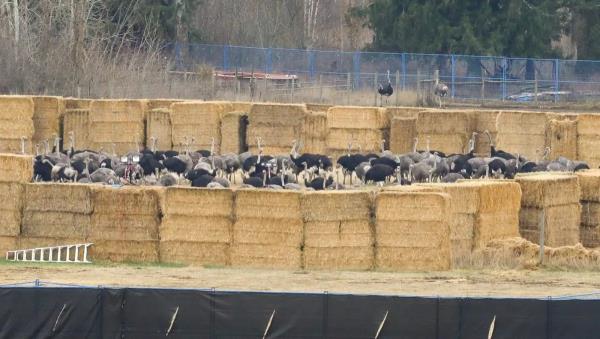
Ostrich flock corralled for depopulation by "marksmen" |
The CFIA failed to conduct a serologic survey or to determine the distribution and prevalence of infection among the flock in December 2024. It is possible that the affected birds were young and devoid of antibody probably present in the older birds, previously subjected to seasonal exposure. The appropriate action at the time would have been to quarantine the flock, maintain a highly level of biosecurity and conduct weekly sampling for the presence of influenza virus applying PCR assay. Given that the farm located in Edgewood was remote from any concentrations of commercial poultry the risk of transmission from the farm was negligible. In any event, since the source of infection was presumably wild birds cohabiting with the ostrich flock their destruction would not have reduced risk to backyard or commercial poultry in the region. Edgewood is located about 70 miles north of the border with Washington State on the Canoe River, located in the Pacific migratory flyway.
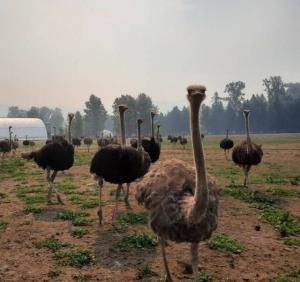 The courts cannot be faulted on their rulings that are based on clearly defined regulations that define ostriches as “poultry”. The unhappy outcome for the healthy birds and their owners is attributed to CFIA intransigence and slavish conformity to regulations relating to the control of avian influenza, seasonally prevalent among poultry flocks. The courts cannot be faulted on their rulings that are based on clearly defined regulations that define ostriches as “poultry”. The unhappy outcome for the healthy birds and their owners is attributed to CFIA intransigence and slavish conformity to regulations relating to the control of avian influenza, seasonally prevalent among poultry flocks.
A public relations campaign mounted by the owners of Universal Ostrich to avert depopulation was ineffective. The intervention of Robert F. Kennedy Jr, U.S. Secretary of Health and Human Services was ill-advised and possibly counterproductive. The claim that the ostriches had been hyper-immunized against specific antigens was a spurious justification to preserve the flock given the rigidity of the CFIA.
The Universal Ostrich episode is an example of apparachiks implementing regulations that should be interpreted based on established scientific principles. The owners have been deprived of their flock that did not represent any risk to commercial poultry in November 2025. Depopulation did nothing to eradicate HPAI that is constantly introduced on to farms by wild migratory and possibly resident birds. The futility of this exercise is exemplified by the ongoing outbreaks of HPAI in flocks in a number of Canadian provinces.
To end with a Dickensian theme, the lyrics of the Broadway show, Oliver based on the eponymous novel, has Fagin stating, “I think I have to think it out again.” This would be sage advice for the CFIA. They should have recognized the futility of depopulation in November 2025, an action carried out without determining either the infective or antibody status of the flock.

|
DxE Activist Found Guilty
|
11/24/2025 |
|
 Zoe Rosenberg an exponent of Direction Action Everywhere (DxE) “welfare theater” was found guilty on a number of charges including trespass, theft and conspiracy. The verdict relates to an incident involving illegal intrusion into a Petaluma, CA. Perdue Farms plant. The jury summarily rejected claims of “rescue” and “welfare” to justify her actions Zoe Rosenberg an exponent of Direction Action Everywhere (DxE) “welfare theater” was found guilty on a number of charges including trespass, theft and conspiracy. The verdict relates to an incident involving illegal intrusion into a Petaluma, CA. Perdue Farms plant. The jury summarily rejected claims of “rescue” and “welfare” to justify her actions
In past years, DxE activists have broken into numerous California poultry facilities and posed a farm or plant employees and committed various misdemeanors and felonies.
It is possible that illegal entry into California farms may have introduced infection or predisposed flocks to pathogens. There is no morality in stealing poultry from farms in the guise of “rescue”. The actions of DxE members are intended to generate publicity for their cause and to satisfy an innate compulsion to damage intensive livestock production.

Advocacy is permissible. Extreme zealotry resulting in criminal action cannot be condoned. Members of DxE are entitled to their beliefs and can express their views but only within the law. Once they cross the line they are no longer activists but criminals.

|
Target Struggles to Restore Sales
|
11/23/2025 |
|
Target has introduced a new policy intended to improve customer satisfaction. Associates are now encouraged to smile and interact with customers. If incoming CEO Michael Fiddelke considers this to be the solution to declining sales and traffic, Target will continue to languish in financial performance. At my local Target Superstore in Durham, NC. where this commentator occasionally shops, smiles from associates would be welcomed if there were in fact associates. Rows of unmanned checkout stations result in congestion at the few that operate.

According to the November 19th release of Q3 2025 financials, the company earned $689 million on revenue of $23,270 million with a diluted EPS of $1.51 million. This compares with Q3 2024 net earnings of $854 million on revenue of $25,668 million with a diluted EPS of $1.85.
Gross margin was 28.2 percent compared to 28.3 percent in the corresponding third quarter of 2024. Operating margin declined from 4.4 percent to 3.8 percent. Comparable same store sales were 3.8 percent lower consistent with a 1.5 percent decline in total sales.
In commenting on the quarter, incoming Fiddelke noted, “We continue to focus on the important work to deliver on our three key priorities: solidifying our  merchandizing authority, elevating the shopping experience and further harnessing the power of technology to move at greater pace and consistency.” merchandizing authority, elevating the shopping experience and further harnessing the power of technology to move at greater pace and consistency.”
Target guidance included a low-single digit decline in sales and full year EPS of $7.70 to $8.70 on a GAAP basis. Litigation, severance settlements and asset charges will reduce diluted EPS to a range of $7.00 to $8.00.

|
CDC Declares SE Outbreak Over
|
11/23/2025 |
|
 The SE outbreak attributed to eggs produced by County Eggs, LLC located in Lucerne Valley, CA. is now officially over. Laboratory investigations confirmed 105 cases in 14 states with patients ranging in age from infants to 90 years. It is significant that approximately 20 percent of confirmed cases required hospitalization. Cases extended from January 7th to August 14th 2025. Given the known disparity between actual and confirmed cases, CDC estimated that as many as 3,000 consumers may have been affected. The SE outbreak attributed to eggs produced by County Eggs, LLC located in Lucerne Valley, CA. is now officially over. Laboratory investigations confirmed 105 cases in 14 states with patients ranging in age from infants to 90 years. It is significant that approximately 20 percent of confirmed cases required hospitalization. Cases extended from January 7th to August 14th 2025. Given the known disparity between actual and confirmed cases, CDC estimated that as many as 3,000 consumers may have been affected.
The outbreak was initially detected using the PulseNet System. Whole genome sequencing confirmed the commonality of isolates from patients and with trace-back to the implicated farm. It is significant that the SE isolate involved was resistant to nalidixic acid and ciprofloxacin, widely used as an antibiotic to treat bacterial infections including salmonellosis.

Given that infected flocks were allowed outside access, County Eggs, LLC will have difficulty in decontaminating soil in the vicinity of houses. Since the implicated eggs were sold from July through September, it will be interesting to learn of the results of routine mandated environmental sampling since this would denote the sensitivity of current surveillance procedures. Details of the vaccination status of flocks would also be of interest.

|
Securing a Reliable Supply of Vitamins and Synthetic Amino Acids
|
11/23/2025 |
|
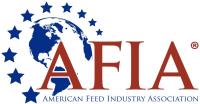 EGG-NEWS strongly endorses the appeal to U.S. trade officials to establish a policy to ensure regular availability of vitamins and synthetic amino acids. According to a study conducted by the Institute for Feed Education and Research of the American Feed Industry Association (AFIA), the U.S. requires approximately 425,000 metric tons of the major essential amino acids and 50,000 metric tons of vitamin supplements to produce 250 million metric tons of feed annually. EGG-NEWS strongly endorses the appeal to U.S. trade officials to establish a policy to ensure regular availability of vitamins and synthetic amino acids. According to a study conducted by the Institute for Feed Education and Research of the American Feed Industry Association (AFIA), the U.S. requires approximately 425,000 metric tons of the major essential amino acids and 50,000 metric tons of vitamin supplements to produce 250 million metric tons of feed annually.

At issue is the reliance of the U.S. on the Peoples Republic of China. Over decades, major additive manufacturers located in the U.S. and the EU established production facilities in China to synthesize vitamins and amino acids. This approach was based on minimizing cost, favorable government support and relative freedom from environmental restraints that exist in Europe and the U.S. Our reliance on China has created vulnerability paralleling the situation with pharmaceuticals and their precursor compounds.
AFIA President and CEO, Constance Cullman stated, “New data now makes it impossible for policymakers to ignore an alarm that has grown too loud and too threatening to dismiss.” Ms. Cullman added, “The animal feed industry appreciates the Trump Administration and lawmaker recent action to discuss this critical issue and is looking forward to working together with others across the food and agriculture value chain to develop risk-and science-based solutions that promote a more reliable stable future food and feed supply.”

Production efficiency, especially for monogastric species would be seriously impaired with shortages of critical ingredients including amino acids, Vitamins D and E and some B Vitamin compounds that currently are supplied almost entirely by China.
Short term solutions include negotiation and leverage using tariffs. Over the intermediate period sourcing from the E.U. or from reputable manufacturers in Asia should reduce reliance on China. Long-term the U.S. must consider onshoring to establish secure supplies of critical ingredients.

|
Kroger Develops New Distribution Model
|
11/22/2025 |
|
 The Board and management of the Kroger Co. have reviewed the considerable capital investment made by the previous CEO Rodney McMullen in Ocado mechanized installations functioning as centers for a hub-and-spoke delivery model. The original plan involving equity in the UK provider of automated warehousing involved numerous fixed installations with hub facilities to deliver groceries directly to homes. Given the considerable investment and possibly technical problems encountered with the initial installations have prompted a re-evaluation of policy following the departure of the previous CEO. Kroger will close three Ocado fulfillment facilities taking a $2.6 billion charge during the third quarter of FY 2025. The Board and management of the Kroger Co. have reviewed the considerable capital investment made by the previous CEO Rodney McMullen in Ocado mechanized installations functioning as centers for a hub-and-spoke delivery model. The original plan involving equity in the UK provider of automated warehousing involved numerous fixed installations with hub facilities to deliver groceries directly to homes. Given the considerable investment and possibly technical problems encountered with the initial installations have prompted a re-evaluation of policy following the departure of the previous CEO. Kroger will close three Ocado fulfillment facilities taking a $2.6 billion charge during the third quarter of FY 2025.

The company has now announced a hybrid approach incorporating store-based fulfillment with third-party delivery services but with retention of viable automated fulfillment centers. Kroger is now working closely with Instacart and DoorDash with the prospect of an affiliation with Uber Eats to combine grocery and meal deliveries.
In retrospect, the McMullen initiative was over-ambitious and incurred high up-front capital costs. Since the concept was conceived and implemented during the COVID period, there have been profound changes in the grocery market, with a return by consumers to brick-and-mortar locations, the rise in club stores and 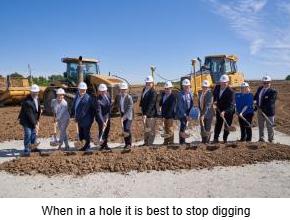 the growth of alternative delivery systems through increased efficiency and consolidation. These factors reduced the relative ROI from the Ocado fulfillment centers. The apparent failure of the hub-and-spoke distribution is exemplified by an early initiative by Kroger to enter the Florida grocery area without supermarkets in an attempt to compete with established grocery retailers including Publix. On face value this approach was highly speculative with reality becoming apparent over the past two years. the growth of alternative delivery systems through increased efficiency and consolidation. These factors reduced the relative ROI from the Ocado fulfillment centers. The apparent failure of the hub-and-spoke distribution is exemplified by an early initiative by Kroger to enter the Florida grocery area without supermarkets in an attempt to compete with established grocery retailers including Publix. On face value this approach was highly speculative with reality becoming apparent over the past two years.

|
Mantiqueira USA Acquires Hickman’s Egg Ranch
|
11/22/2025 |
|
 Following the acquisition by JBS of half the equity of Mantiqueira, a major egg producer in Brazil, the parent company indicated that it would establish a presence in the U.S. To this end, Murilo Scarpa Pinto, son of Leandro Pinto, the founder of Mantiqueira moved to the U.S. to spearhead the company involvement in the domestic egg industry. The initial strategy was to purchase an existing large egg company and to concurrently plan and erect a complex of up to two million hens. Following the acquisition by JBS of half the equity of Mantiqueira, a major egg producer in Brazil, the parent company indicated that it would establish a presence in the U.S. To this end, Murilo Scarpa Pinto, son of Leandro Pinto, the founder of Mantiqueira moved to the U.S. to spearhead the company involvement in the domestic egg industry. The initial strategy was to purchase an existing large egg company and to concurrently plan and erect a complex of up to two million hens.
This past week JBS USA announced the purchase of the family-owned Hickman’s Egg Ranch headquartered in Arizonia but with a partly-owned subsidiary, Central Valley Eggs located in California. In announcing the acquisition Wesley Batista Filho CEO of JBS USA noted, “By partnering with the Pinto Family through MTQ USA, we are creating strong synergies that will enhance collaboration, improve efficiency, and accelerate innovation.” He added, “We see significant opportunity to deliver more value to customers across the country.”
The acquisition follows the loss to HPAI of almost six million hens comprising the Arizona complexes owned and operated by Hickman’s Egg Ranch. Glenn Hickman , CEO recently stated, “The trauma of going from six million chickens down to nothing in a period of three weeks is more than our family wants to take a chance on again.”
In an interview with a local television station Hickman criticized the USDA policy on control of HPAI stating, “The federal government has declined to become involved and try to figure out solutions and protection for our flocks.”
Given the challenges of restoring the Hickman’s flocks, restructuring and adapting the culture to the corporate requirements of JBS will occupy management in the intermediate term. Accordingly erection of a green field complex in either Utah or Colorado may be deferred. There will be obvious challenges in applying production practices and policies appropriate to Brazil that will be applicable to the U.S. market. In addition, much of the expertise of JBS in broiler production and marketing will be inappropriate to the U.S. situation.
The Mantiqueira acquisition of Hickman’s Egg ranch is the second investment by Brazil in the U.S. industry in 2025. Hillandale Farms was acquired in May by Global Eggs S.a.r.l. controlled by entrepreneur Ricardo Faria as a going concern. The two operations, functioning under ownership by companies with roots in Brazil will amount to 26 million hens representing eight percent of the U.S. nominal flock of 325 million hens.

|
Interview with Dr. Clovis Rayzel on his Retirement
|
11/21/2025 |
|
Dr. Clovis Rayzel, president and CEO of Big Dutchman Inc. will retire at the end of 2025 after 28 years with the company. He has extensive experience in field production of poultry and hogs in the Americas, Europe and Asia where he has been involved in international marketing and sales.
During the transition to his retirement, EGG-NEWS had the opportunity to review his career and share his views on current events and future trends in the egg industry for the benefit of subscribers.
EGG-NEWS: Clovis, please describe your background and training.
CR: I graduated from the University of Santa Catarina, Brazil with a doctoral degree in Veterinary Medicine in 1985. Thereafter I undertook graduate studies through the International Agricultural Center in Wageningen, the Netherlands in 1993 and completed a Master of Science in Animal Production at South Dakota State University in 1995. My formal training was supplemented by extensive interaction with the industry through attendance at national and international meetings, tradeshows and frequent travel on four continents
EGG-NEWS: Your early career involved direct contact with farmers, flocks and herds. Please expand on your activities.
CR: From 1986 through 1997 I functioned as a Field Service Veterinarian advising members of two major cooperatives in Santa Catarina State. Advancing to the Cooperativa Central Aurora in Chapeco SC, I served as the Department Manager for Animal Nutrition and Feed Production. This cooperative incorporated sixteen affiliate groups with over 5,000 employees processing six million broilers and 100,000 hogs annually.
EGG-NEWS: When did you join Big Dutchman?
CR: In 1997 I was appointed as Sales and Marketing Manager for Latin America based in St. Peterburg, FL. This position required extensive travel among nations in Central and South America, participating in the expansion of poultry and swine industries in both developing and developed regions.
EGG-NEWS: When did you move to Michigan?
CR: With my August 2001 appointment as Vice-president, International Sales and Marketing. Subsequently in 2005 I was appointed as president and CEO of Big Dutchman Inc. with responsibilities for Canada, the U.S., Latin America and Caribbean. Currently Big Dutchman AG., the parent company, has a presence in over 100 nations designing and manufacturing equipment and systems for poultry and swine with affiliates in plant production and agricultural technology for sustainability and productivity.
EGG-NEWS: Please describe some of your accomplishments in your position as president and CEO.
CR: We have built a strong team that has contributed to the success of the egg industry in regions of my responsibility. We have a strong distributor network to support expansion and retrofits, and are fully prepared to interact directly with farmers when that is the preference. I believe we are the leaders in technology required for the transition from conventional cages to alternative systems including both aviaries and barn housing.
EGG-NEWS: Kindly share your appraisal of the U.S. egg industry including growth prospects and trends in housing and equipment.
CR: The key consideration will be the rate of expansion in relation to profitability and return on investment. The trajectory of implementing alternative systems appears to be slowing after the rapid transition over the past decade. The industry appears to have bifurcated with aviary systems for large in-line complexes and barn housing with or without outside access for both vertical and horizontal integration. We have witnessed the emergence and expansion of companies supplied by independent contractors specializing in packing and marketing. In some respects, the barn segment of the U.S. model is paralleling traditional systems in the EU.
EGG-NEWS: Do you foresee major changes in housing systems over the next five years?
CR: Big Dutchman has been a leader in innovation among alternative systems with true aviaries that optimize both production and welfare. Currently production parameters in aviaries are approaching cage housing with respect to egg production, livability, and feed consumption. There is still a positive differential in revenue for cage-free eggs that offsets higher labor and feed costs for non-confined housing. Irrespective of systems, Big Dutchman is allowing producers to optimize genetic potential of brown and white-feathered strains through appropriate design, project implementation and after-sales guidance and service,
EGG-NEWS: Do you foresee continued use of cages?
CR: Undoubtedly markets will support confined housing for a significant proportion of the national flock. We continue to deliver enrichable cages that can be converted at some later time to enriched modules. It is possible that the industry under coercion and pressure by animal rights groups adopted aviaries and floor systems during the 2010s. to the exclusion of colony modules. For a variety of reasons the Industry rejected enriched modules that were in fact accepted in principle by HSUS under the abandoned “Egg Bill” that would have established a national housing standard. In an environment characterized by uncertainty as a result of litigation and lobbying, the industry must exercise flexibility. In response to the needs of the industry Big Dutchman offers a comprehensive range of alternatives to support producers.
EGG-NEWS: Do you have any messages for the industry?
CR: Be aware of consumer needs and respond appropriately, be it welfare, technology or other aspects of housing. Avian influenza has become a major factor in determining price and profitability. It is evident that the infection is endemic throughout the world’s poultry populations, will persist and that biosecurity alone does not provide absolute protection. Alternative modalities including vaccination will be necessary to maintain productivity. The egg industry should continue to stress nutritional value and should strive to achieve uniformly high quality with freedom from foodborne infection.
EGG-NEWS: What are your plans for retirement?
CR: I will remain in contact with the industry and will serve as a consultant to Big Dutchman sharing my experience and contacts on this and other continents.
EGG-NEWS: Thank you Clovis and wishing you well in the coming years.

|
REVIEW OF OCTOBER 2025 EGG PRODUCTION COSTS.
|
11/17/2025 |
|
This update of U.S egg-production costs and prices is provided for the information of producers and stakeholders. Statistical data was unavailable due to the Federal shutdown. Updates will hopefully be available for inclusion in the December edition. September values for production and October cost and price updates provided by the EIC are included in this review
OCTOBER HIGHLIGHTS
- October 2025 USDA ex-farm blended USDA nest-run, benchmark price for conventional eggs from caged hens was 117 cents per dozen, down 58 cents per dozen or 33.1 percent from the September 2025 value of 175 cents per dozen. The corresponding October 2023 and 2024 values were respectively $0.80 and $2.87 cents per dozen. For annual comparison, average monthly USDA benchmark price over 2023 was 146 cents per dozen compared to 247 cents per dozen covering 2024. Stock levels and prices prior to the onset of flock depletions due to HPAI indicated a relative seasonal balance between supply and demand. Future nest-run and wholesale prices will be largely dependent on consumer demand for shell eggs and products, as determined by the economy, supply as influenced by re-emergence of HPAI, net imports and the rate of replacement of pullets and hens depleted. Other considerations include diversion to shell sales from the egg-breaking sector in an interconnected industry. Imports declined sharply during the past quarter although the U.S. ran a negative trade balance through July.
- October 2025 USDA ex-farm negotiated USDA nest-run, benchmark price for all categories of cage-free eggs was 134 cents per dozen, down 13 cents per dozen or 8.8 percent from the September 2025 value of 147 cents per dozen. The corresponding October 2023 and 2024 values were respectively 120 and 208 cents per dozen.
- Fluctuation in wholesale price is attributed in part to the amplification of upward and downward swings associated with the commercial benchmark price-discovery system in use. An important factor influencing pricing is the proportion of shell eggs supplied under cost-plus contracts accentuating the upward and downward price trajectory of uncommitted eggs as determined by the price discovery system. Highly pathogenic avian influenza was the major driver of price in 2024 and through Q1 of 2025 due to the high incidence rate. Approximately 40 million hens and at least 2.0 million pullets were depleted in 2024 with close to an additional 36 million birds, (hens and pullets) in 35 complexes or farms through mid-May 2025. The Fall 2025 losses involved two complexes of 3.1 million hens in late September and 2.0 million in early October.
- October 2025 USDA average nest-run production cost for conventional eggs from caged flocks over four regions (excluding SW and West), applying updated inputs was 73.8 cents per dozen, down 0.8 cents from September 2025 at 73.8 cents per dozen. The October average nest run production cost for other than caged and certified organic hens was estimated by the EIC to be 93.1 cents per dozen down 0.8 cent per dozen from September. Approximately 60 cents per dozen should be added to the USDA benchmark nest-run costs to cover processing, packing material and transport to establish a realistic cost value as delivered to warehouses.
- October 2025 USDA benchmark nest-run margin for conventional eggs attained a positive value of 43.2 cents per dozen compared to a positive margin of 100.4 cents per dozen in September 2025. Year to date the average monthly nest-run production margin has attained 271.0 cents per dozen. Average nest-run monthly margin for 2024 was 170.8 cents per dozen compared to 64.2 cents per dozen in 2023 and 155 cents in 2022.
- October 2025 USDA benchmark nest-run margin for all categories of cage-free eggs attained a positive value of 40.9 cents per dozen compared to a positive margin of 53.1 cents per dozen in September 2025. Year to date the average monthly nest-run production margin has attained 321.1 cents per dozen. Average nest-run monthly margin over 2024 was 440 cents per dozen compared with 100 cents per dozen in 2023, relatively unaffected by HPAI compared to the preceding and following years.
Since data for October production and September exports was unavailable as of mid-November values for the most recent reported month of August are retained in the following paragraphs.
- The August 2025 national flock (over 30,000 hens per farm) was stated by the USDA to be up by 6.6 million hens (rounded, and a probable undercount) to 285.9 million compared to approximately 326 million before the advent of the H5N1 epornitic of HPAI in 2022. Approximately 3.5 million hens returned to production from molt during the month together with projected maturation of 23 million pullets, with the total offset by depletion of an unknown number of spent hens. On October 8th USDA estimated the total U.S table-egg production flock at 304.5 million with 298.1 million actually in production.
- August 2025 pullet chick hatch of 28.7 million was down 0.4 million (-1.4 percent) from July 2025 but inconsistent with an increased industry need to replace depopulated flocks.
- August September export data will be released after resumption of Federal activities. In July 2025 exports of shell eggs and products combined were up 27.1 percent from June 2025 to 376,600 case equivalents representing the theoretical production of 5.6 million hens. Shell egg exports totaling 72,000 cases were dominated by Canada (38 percent of volume) the “Rest of Americas” including the Caribbean (40 percent). With respect to 304,000 case equivalents of egg products, importers comprised Canada (32 percent of volume), “Rest of Americas and the EU (each 20 percent), Japan, (12 percent), Mexico, (8 percent) collectively representing 98 percent of shipments. Volumes exported are based on the needs of importers, competing suppliers, availability in the U.S. and FOB prices offered.
- According to the USDA Egg Market Overview released on September 8th, all egg imports (shell, liquid and dry) in July attained 19.5 million dozen shell equivalents compared to exports of all categories of 11.2 million dozen shell equivalents.
- For 2025 through July the negative trade balance in all shell and derived egg products attained 15.5 million dozen shell equivalents.
 |
TABLES SHOWING KEY PARAMETERS FOR SEPTEMBER 2025.
Summary tables for the latest USDA October 2025 costs and unit prices were made available by the EIC on November 7th 2025. Data is arranged, summarized, tabulated and compared with values from the previous October 13th 2025 release reflecting September 2025 costs and production data, as revised and applicable. Monthly comparisons of production data and costs are based on revised USDA and EIC values.
VOLUMES OF PRODUCTION REFLECTING THE ENTIRE INDUSTRY
|
PARAMETER
|
SEPTEMBER 2025
|
OCTOBER 2025*
|
|
Table-strain eggs in incubators
|
55.0 million (Sept.)
|
(Oct.)
|
|
Pullet chicks hatched
|
28.7 million (Aug.)
|
million (Sept.)
|
|
Pullets to be housed 5 months after hatch
|
25.9 million (Jan. ‘26)
|
million (Dec.)
|
|
EIC 2025 December 1st U.S. total flock projection
|
316.7 million (Sept.)
|
million (Oct.)
|
|
National Flock in farms over 30,000
|
285.9 million (Aug.)
|
million (Sept.)
|
|
National egg-producing flock
|
299.0 million (Aug.)
|
307.4 million (Oct.12)1
|
|
Cage-free flock excluding organic
Cage-free organic flock
|
116.6 million (Sept.)
20.0 million (Sept.)
|
million (Oct.)
million (Oct.)
|
|
Proportion of flocks in molt or post-molt
|
11.9% (Sept)
|
% (Oct.)
|
|
Total of hens in National flock, 1st cycle (estimate)
|
253.4 million (Aug.)
|
million (Sept.)
|
*USDA data unavailable 1. From USDA Weekly Shell-egg Demand Indicator
|
Total U.S. Eggs produced (billion)
|
7.59 August 2025
|
September 2025
|
|
Total Cage-Free hens in production
Proportion of organic population
|
136.6 million (Sept.)
14.6% Organic
|
million (Oct.)
% Organic
|
|
“Top-5” States hen population (USDA)1
|
-
- million (Aug.)
|
million (Sept.)
|
*Revised USDA/EIC Note 1. Texas excluded to maintain confidentiality
PROPORTION OF U.S. TOTAL HENS BY STATE, 2025
Based on a nominal denominator of 285 million hens in flocks over 30,000 covering 95 percent of the U.S complement.
USDA has amended inclusion of specific states in regions and eliminated Texas data to protect confidentiality of Company flock
Sizes
|
STATE
|
AUGUST1
2025
|
SEPTEMBER
2025
|
|
Iowa
|
15.3%
|
%
|
|
Indiana
|
12.2%
|
%
|
|
Ohio
|
12.5%
|
%
|
|
Pennsylvania
|
8.0%
|
%
|
|
Texas (estimate)
|
8.3% ?
|
%?
|
|
California
|
1.7%
|
%
|
- Values rounded to 0.1%
Rate of Lay, weighted hen-month (USDA) 81.5 September 2025. % October 2025
*Revised USDA
|
Revised per capita
|
Egg consumption 2020
|
285.6 (down 7.8 eggs from 2019)
|
|
Revised per capita
|
Egg consumption 2021
|
282.5 (down 3.1 eggs from 2020)
|
|
Actual per capita
|
Egg consumption 2022
|
280.5 (down 2.0 eggs from 2021 due to HPAI)
|
|
Actual per capita
|
Egg consumption 2023
|
278.0 (down 2.5 eggs from 2022)
|
|
Actual per capita
Forecast per capita
Projection per capita
|
Egg consumption 2024
Egg consumption 2025
Egg consumption 2026
|
270.6 (down 7.2 eggs from 2023) attributed to HPAI losses*
261.0 (down 9.6 eggs from 2024) forecast adjusted for HPAI losses , was 258.2 last month but this was aspirational
276.4 (up 18.4 eggs from 2025 assuming restoration of flocks and without HPAI losses)
|
*Revised, using data from USDA Livestock, Dairy and Poultry Outlook September 18th 2025 taking into account demand from the food service sector and presumably including the effect of HPAI depopulation and net importation.
EGG INVENTORIES AT BEGINNING OF SEPTEMBER 2025:
|
Shell Eggs
|
1.44 million cases down 14.7 percent from September 20251
|
|
Frozen Egg
Products
|
514,960 case equivalents, up 28.0 percent from August 2025
|
|
Dried Egg
Products
|
Not disclosed since March 2020 following market disruption due
To COVID. Moderate levels of inventory are assumed.
|
1. USDA Shell-egg Demand Indicator. November 12th.
EGGS BROKEN UNDER FSIS INSPECTION (MILLION CASES) AUGUST 2025, 7.03 SEPTEMBER 2025,
|
Cumulative eggs broken under FSIS inspection 2024 (million cases)
|
77.2
|
JAN. TO DEC.
|
|
Cumulative 2024: number of cases produced (million)
|
257.9
|
JAN. TO DEC.
|
|
Cumulative 2024: proportion of total eggs broken
|
29.9%
|
(30.8% 2022)
|
|
|
|
|
|
Cumulative eggs broken under FSIS inspection 2025 (million cases)
|
52.3
|
JAN.-AUG.
|
|
Cumulative 2025: number of cases produced (million)
|
161.6
|
JAN.-AUG.
|
|
Cumulative 2025: proportion of total eggs broken
|
32.3%
|
JAN.-AUG.
|
Export and import data for August was not released due to Federal shutdown.
EXPORTS JULY 2025: (Expressed as shell-equivalent cases of 360 eggs).
|
Parameter
|
Quantity Exported
|
|
Exports:
|
2025
|
|
Shell Eggs (thousand cases)
|
JUNE 148. JULY 72
|
|
Products (thousand case equivalents)
|
JUNE. 148. JULY. 304
|
|
TOTAL (thousand case equivalents)*
|
JUNE. 296. JULY 376
|
*Representing 1.8 percent of National production in JULY 2025 (0.4% shell, 1.4% products).
COSTS AND UNIT REVENUE VALUES1 FOR CONVENTIONAL EGGS FROM CAGED HENS
|
Parameter
|
SEPTEMBER 2025
|
OCTOBER 2025
|
|
4-Region Cost of Production ex farm (1st Cycle)1
|
74.6 c/doz
|
73.8 c/doz
|
|
Low
|
72.7c/doz (MW)
|
71.9 c/doz (MW)
|
|
High
|
76.8 c/doz (NE)
|
75.6c/doz (NE)
|
Notes: 1. Excludes SW and West
Components of Production cost per dozen:-
|
|
SEPTEMBER 2025
|
OCTOBER 2025
|
|
Feed
|
34.0 c/doz
|
33.3c/doz
|
|
Pullet depreciation
|
11.8 c/doz
|
11.8c/doz
|
|
Labor (estimate) plus
|
|
|
|
Housing (estimate) plus
|
28.8c/doz
|
28.7c/doz
|
|
Miscellaneous and other (adjusted May 2023)
|
|
|
Ex Farm Margin (rounded to nearest cent) according to USDA values reflecting OCTOBER 2025:-
117.0 cents per dozen1- 73.8 cents per dozen = 43.2 cents per dozen (September 2025 comparison: 175.0 cents per dozen – 74.6 cents per dozen = 100.4 cents per dozen.
Note 1: USDA Blended nest-run egg price
|
|
|
SEPTEMBER 2025
|
OCTOBER 2025
|
|
USDA
|
Ex-farm Price (Large, White)
|
175.0 c/doz (Sept.)
|
117.0c/doz (Oct.)
|
|
|
Warehouse/Dist. Center
|
231.5 c/doz (Sept.)
|
160.0c/doz (Oct.)
|
|
|
Store delivered (estimate)
|
237.5 c/doz (Sept.)
|
166.0 c/doz (Oct.)
|
|
|
Dept. Commerce Retail1 National
|
359.0 c/doz (Sept.)
|
349.0 c/doz (Oct.)
|
|
|
Dept. Commerce Retail1 Midwest
|
366.0 c/doz (Sept.)
|
333.0 c/doz (Oct.)
|
- Unrealistic USDA values based on advertised promotional prices with few participating stores, non-representative of shelf prices!
|
|
SEPTEMBER 2025
|
OCTOBER 2025
|
|
U.S. Av Feed Cost per ton
|
$219.41
|
$215.59
|
|
Low Cost – Midwest
|
$199.72
|
$195.34
|
|
High Cost – West
|
$255.56
|
$253.05
|
|
Differential
Corn/ton 5 regions
Soybean meal/ton 5 regions
|
$ 55.84
$165.08
$327.15
|
$ 57.71
$165.52
$308.90
|
|
Pullet Cost 19 Weeks
|
$4.61 SEPTEMBER 2025
|
$4.58 OCTOBER 2025
|
|
Pullet Cost 16 Weeks
|
$4.06 SEPTEMBER 2025
|
$4.04 OCTOBER 2025
|
AVERAGE COSTS AND UNIT REVENUE FOR EGGS FROM CAGE-FREE HENS
|
Parameter
|
SEPTEMBER 2025
|
OCTOBER 2025
|
|
5-Region Cost of Production ex farm (1st Cycle)
|
93.9 c/doz
|
93.1 c/doz
|
|
Low
|
89.9c/doz (MW)
|
89.1 c/doz (MW)
|
|
High
|
101.1 c/doz (West)
|
100.6 c/doz (West)
|
Components of Production cost for cage-free eggs, per dozen:-
|
|
SEPTEMBER 2025
|
OCTOBER 2025
|
|
Feed (non-organic)
|
39.3 c/doz
|
38.6 c/doz
|
|
Pullet depreciation
|
15.7 c/doz
|
15.6 c/doz
|
|
Labor (estimate) plus
|
|
|
|
Housing (estimate) plus
|
38.9c/doz
|
38.9 c/doz
|
|
Miscellaneous and other
|
|
|
Ex Farm Margin (rounded to cent) according to USDA values reflecting negotiated price for OCTOBER 2025:-
Cage-Free brown 134.0 cents per dozen1- 93.1 cents per dozen = 40.9 cents per dozen
September 2025:- 147.0 cents per dozen - 93.9 cents per dozen = 53.1 cents per dozen
|
|
|
SEPTEMBER 2025
|
OCTOBER 2025
|
|
USDA
|
USDA Average Ex-farm Price1
Gradable nest run2
|
173 c/doz (Sept.)
134 c/doz. (Sept.)
|
173 c/doz (Oct .)
c/doz. (Oct.)
|
|
|
Warehouse/Dist. Center3
|
215 c/doz (Sept)
|
c/doz (Oct.)
|
|
|
Store delivered (estimate)
|
221 c/doz (Sept)
|
c/doz (Oct.)
|
|
|
Dept. Com. Retail4 C-F White
Dept. Com. Retail4 C-F Brown
|
345 c/doz (Sept.)
340 c/doz (Sept.)
|
c/doz (Oct.)
c/doz (Oct.)
|
|
|
Dept. Com. Retail3 Organic
Dept. Com. Retail3 Pasture
|
568 c/doz (Sept.)
646 c/doz (Sept.)
|
570 c/doz (Oct.)
661 c/doz. (Oct.)
|
1. Contract price, nest-run loose. Range 155 to 210 c/doz. Negligible change since July 2024 and totally unrealistic.
- Negotiated price, loose. Range $1.20 to $2.60 per dozen
- Estimate based on prevailing costs
- Unrealistic USDA values based on promotional prices with few participating stores and non-representative of shelf prices
Cage-Free HPAI losses 2.0 million during October on WA complex
|
Cage-Free* Pullet Cost 19 Weeks
|
$5.61 SEPTEMBER 2025
|
$5.57 OCTOBER 2025
|
|
Cage-Free* Pullet Cost 16 Weeks
|
$4.90 SEPTEMBER 2025
|
$4.89 OCTOBER 2025
|
* Conventional (non-organic) feed
Feed prices used are the average national and regional values for caged flocks. Excludes organic feeds with prices substantially higher than conventional.

|
|
|
|
View More
|
Top
|
|